Cambodian Queen Mother Norodom Monineath Sihanouk mourns for her husband and former King Norodom Sihanouk in Beijing, China, on Monday, Oct. 15, 2012. Sihanouk, the revered former king who was a towering figure in Cambodian politics through a half-century of war, genocide and upheaval, died Monday. He was 89. He had been getting medical treatment in China since January and had suffered a variety of illnesses, including colon cancer, diabetes and hypertension. (AP Photo/Xinhua, Lan Hongguang)
Phnom Penh, Cambodia (AP) – He was many things to the Cambodia he helped navigate through half a century of war and genocide – revered independence hero, ruthless monarch and prime minister, communist collaborator, eccentric playboy, avid filmmaker.
Most of all, perhaps, Cambodia’s former King Norodom Sihanouk was a cunning political survivor who reinvented himself repeatedly throughout his often flamboyant life.
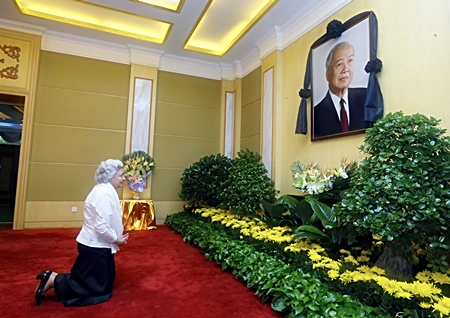 Cambodian Queen Mother Norodom Monineath Sihanouk mourns for her husband and former King Norodom Sihanouk in Beijing, China, on Monday, Oct. 15, 2012. Sihanouk, the revered former king who was a towering figure in Cambodian politics through a half-century of war, genocide and upheaval, died Monday. He was 89. He had been getting medical treatment in China since January and had suffered a variety of illnesses, including colon cancer, diabetes and hypertension. (AP Photo/Xinhua, Lan Hongguang)
Cambodian Queen Mother Norodom Monineath Sihanouk mourns for her husband and former King Norodom Sihanouk in Beijing, China, on Monday, Oct. 15, 2012. Sihanouk, the revered former king who was a towering figure in Cambodian politics through a half-century of war, genocide and upheaval, died Monday. He was 89. He had been getting medical treatment in China since January and had suffered a variety of illnesses, including colon cancer, diabetes and hypertension. (AP Photo/Xinhua, Lan Hongguang)
On Monday, aged 89, Sihanouk died of a heart attack in Beijing, where he had been receiving medical treatment since January for a variety of ailments.
First crowned king by the French in 1941 at the age of 18, Sihanouk saw his Southeast Asian nation transformed from colony to kingdom, from U.S.-backed regime to U.S. bombing zone, from Khmer Rouge killing field to what it remains today – a fragile experiment in democracy.
He ruled as a feudal-style absolute monarch, but called himself a democrat. He was a man who sang love songs at elaborate state dinners, brought his French poodle to peace talks, and charmed foreign dignitaries such as Jacqueline Kennedy.
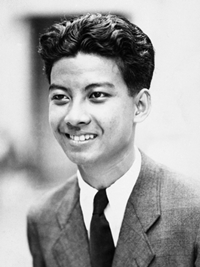 In this July 29, 1941 file photo, Cambodia’s former King Norodom Sihanouk smiles at an unknown location. (AP Photo)
In this July 29, 1941 file photo, Cambodia’s former King Norodom Sihanouk smiles at an unknown location. (AP Photo)
He also painted, fielded a palace soccer team, composed music and led his own jazz band. His appetite extended to fast cars, food and women. He married at least five times – some say six – and fathered 14 children.
When the murderous Khmer Rouge seized power in the 1970s, he was reviled as their collaborator. Yet he himself ended up as their prisoner and lost five of his children to the regime. Later, in the 1990s – after a U.N.-brokered deal to end Cambodia’s long civil war – he recast himself as a peacemaker and constitutional monarch.
In the twilight of his life, Sihanouk suffered colon cancer, diabetes and hypertension. Prince Sisowath Thomico, a royal family member who also was Sihanouk’s assistant and nephew, said the former king passed away before dawn Monday, Oct. 15.
“His death was a great loss to Cambodia,” Thomico said, adding that Sihanouk had dedicated his life “for the sake of his entire nation, country and for the Cambodian people.”
In 2004, Sihanouk abdicated the throne, citing his poor health. The move paved the way for his son Norodom Sihamoni to take his place.
On Monday, Sihamoni flew to China with Prime Minister Hun Sen to retrieve Sihanouk’s body. State flags flew at half-staff, and Cambodian government spokesman Khieu Kanharith said a week of official mourning would be held once the former king’s body is repatriated on Wednesday. A cremation ceremony will be held in three months, according to Buddhist tradition.
While officials said they expect as many as 100,000 to line the route from the airport to the Royal Palace for the return of Sihanouk’s body, the immediate reaction in the capital seemed muted, partly because it was a holiday, which took many people out of town.
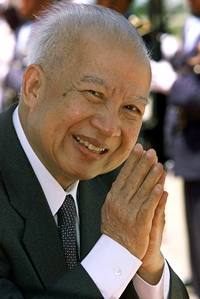 In this July 17, 2001 file photo, Cambodia’s King Norodom Sihanouk acknowledges the crowd while walking to greet North Korea’s national assembly leader Kim Yong Nam at Phnom Penh airport, in Cambodia. (AP Photo/Andy Eames, File)
In this July 17, 2001 file photo, Cambodia’s King Norodom Sihanouk acknowledges the crowd while walking to greet North Korea’s national assembly leader Kim Yong Nam at Phnom Penh airport, in Cambodia. (AP Photo/Andy Eames, File)
One of those mourning was 67-year-old Yos Sekchantha, who said she offered prayers that his soul would rest in peace.
“I don’t know much about politics, but the king father was really a good leader and cared about his county and people,” she said as tears welled in her eyes.
Many Cambodians, though, are too young to have emotional bonds to a man who in the past two decades has been overshadowed by Hun Sen, the country’s current political strongman.
In January, Sihanouk requested he be cremated in the Cambodian and Buddhist tradition. He asked that his ashes be put in an urn, preferably made of gold, and placed in a stupa at the Royal Palace.
Born Oct. 31, 1922, Sihanouk enjoyed a pampered childhood in French colonial Indochina. In 1941, the French crowned him king instead of other relatives closer in line to the throne because they thought the pudgy, giggling prince would be easy to control.
They were the first of many to underestimate him, and by 1953 the French were out.
In 1955, Sihanouk stepped down from the throne, organized a mass political party and went on to hold various positions as head of government and state.
Through those years, he steered Cambodia toward uneasy neutrality at the height of the Cold War and was a founder of the Non-Aligned Movement.
In 1965, he broke off relations with Washington as U.S. involvement in the Vietnam War shifted into high gear. But by 1969, worried about increasing Vietnamese communist use of Cambodian soil, he made new overtures to America and turned away from China.
Sihanouk’s top priority was to keep Cambodia out of the war, but he could not. U.S. aircraft bombed Vietnamese communist sanctuaries in Cambodia with increasing regularity, over his public protests. Privately, U.S. officials believed, he had given tacit permission for the attacks on Vietnamese communist sanctuaries near Cambodia’s eastern border.
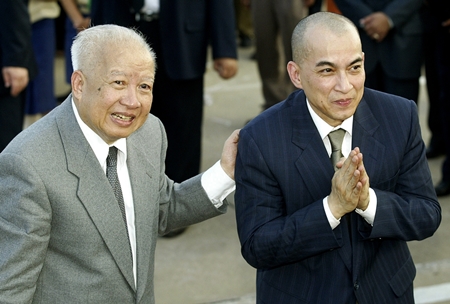 In this Oct. 20, 2004 file photo, Cambodia’s King Norodom Sihanouk, left, introduces his son and successor, King Norodom Sihamoni upon their arrival at Phnom Penh airport, in Cambodia. (AP Photo/Andy Eames, File)
In this Oct. 20, 2004 file photo, Cambodia’s King Norodom Sihanouk, left, introduces his son and successor, King Norodom Sihamoni upon their arrival at Phnom Penh airport, in Cambodia. (AP Photo/Andy Eames, File)
Internally, Cambodia was a one-man show. Sihanouk’s sharpest critics accused him of running a medieval state as an ancient Khmer ruler reincarnated in Western dress.
“I am Sihanouk,” he once said, “and all Cambodians are my children.”
Indeed, many adored Sihanouk as a near-deity.
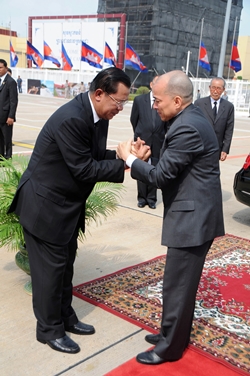 In this photo released by China’s Xinhua News Agency, Cambodian King Norodom Sihamoni, right, shakes hands with Cambodian Prime Minister Hun Sen at the airport in Phnom Penh on Monday, Oct. 15, 2012. Sihamoni and Hun Sen flew to Beijing on Monday morning to retrieve the body of former King Norodom Sihanouk who died at the age of 89. (AP Photo/Xinhua, Zhao Yishen)
In this photo released by China’s Xinhua News Agency, Cambodian King Norodom Sihamoni, right, shakes hands with Cambodian Prime Minister Hun Sen at the airport in Phnom Penh on Monday, Oct. 15, 2012. Sihamoni and Hun Sen flew to Beijing on Monday morning to retrieve the body of former King Norodom Sihanouk who died at the age of 89. (AP Photo/Xinhua, Zhao Yishen)
In 1970, though, Sihanouk was overthrown in a U.S.-backed coup that came while he was abroad on a trip that included a stay at a French weight-loss clinic. He spent years of lonely, if lavish, exile in Beijing.
Seeking to regain the throne, he joined the communist Khmer Rouge-dominated rebels after his overthrow. Only a few years earlier, his government had been suppressing them in the city and countryside.
They had numbered only a few hundred until the coup, but his presence gave them a legitimacy they had never before enjoyed.
The alliance left Sihanouk open to subsequent criticism that he opened the way for the Khmer Rouge holocaust. But his relations with the communist group were always strained.
“The Khmer Rouge do not like me at all, and I know that. Ooh, la, la … It is clear to me,” he said in a 1973 interview. “When they no longer need me, they will spit me out like a cherry pit.”
When the Khmer Rouge seized power in 1975, Sihanouk returned home. But he was detained and the former rebels ordered his execution. Only the personal intervention of Chinese leader Zhou Enlai saved him.
With Sihanouk under house arrest in the Royal Palace, the Khmer Rouge ran an ultra-radical Maoist regime from 1975 to 1979, emptying the cities to create a vast network of forced labor camps. An estimated 1.7 million Cambodians were executed or died of disease and hunger under their rule.
Vietnam invaded in 1978 and toppled the Khmer Rouge. Freed as the Vietnamese advanced on Phnom Penh, Sihanouk found exile in Beijing and North Korea.
From there, he nominally headed an unlikely coalition of three guerrilla groups – including his former Khmer Rouge captors – fighting the Vietnamese-installed puppet government. The war lasted a decade.
Sihanouk remained a unifying figure, though, going on to lead the U.N.-supported interim structure that ran Cambodia until 1993 elections.
The same year, Sihanouk re-ascended the throne in a traditional Khmer coronation. Restored to his palace and travelling the countryside with personal bodyguards on loan from North Korea, he assumed a new role as beloved father of the country – even though many adoring, older Cambodians expressed hope for a return of his previous direct rule.
But the bright promise of the elections soon faded.
Four years after the polls, Hun Sen launched a violent coup, and he remains in power to this day.
In the last years of his life, Sihanouk’s profile and influence receded. While older people in the countryside still held him in reverence, the young generation regarded him as a figure of the past and one partly responsible for Cambodia’s tragedy.
Rarely at a loss for words, he became for a time a prolific blogger, posting his musings on current affairs and past controversies. Most of his writing was literally in his own hand – his site featured images of letters, usually in French in a cramped cursive script, along with handwritten marginalia to news clippings that caught his interest.
His production tailed off, however, as he retreated further from the public eye, spending more and more time under doctors’ care in Beijing.
The hard-living Sihanouk had suffered ill health since the early 1990s. He endured cancer, a brain lesion and arterial, heart, lung, liver and eye ailments.
In late 2011, on his return from another extended stay in China, Sihanouk dramatically declared that he never intended to leave his homeland again. But true to his mercurial reputation, he flew off to Beijing just a few months later for medical care.
Associated Press writers Kay Johnson, Grant Peck, Denis Gray and Todd Pitman in Bangkok contributed to this report.
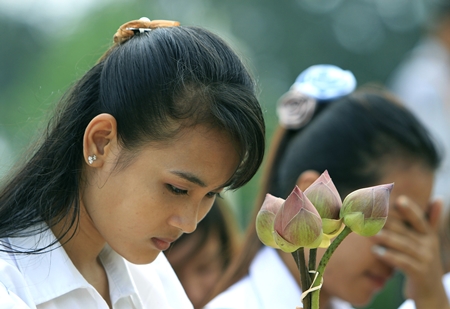 Cambodian students hold lotus flowers while praying in front of the main gate of the Royal Palace in Phnom Penh, Cambodia, to mourn the death of former King Norodom Sihanouk Tuesday, Oct. 16, 2012. (AP Photo/Heng Sinith)
Cambodian students hold lotus flowers while praying in front of the main gate of the Royal Palace in Phnom Penh, Cambodia, to mourn the death of former King Norodom Sihanouk Tuesday, Oct. 16, 2012. (AP Photo/Heng Sinith)




